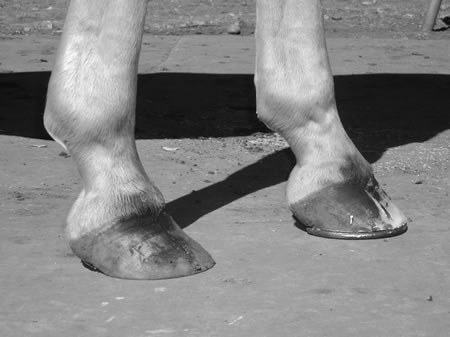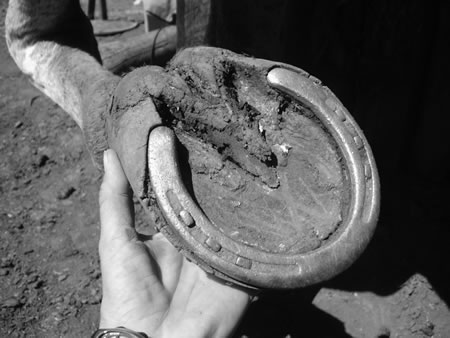Written by Sue Stuska Ed.D
Hoof Function in Movement
The horse’s hoof is an amazing structure. Understanding how it works will help us make good shoeing and trimming decisions in cooperation with the farrier.
 The barefoot hoof lands on the full near-circular extent of the wall. The wall’s toe is relatively thick (from inside to outside), so it doesn’t flex much, but the wall at the quarters is thinner and allows the hoof to flatten out as it contacts the ground. The heels of the wall are also relatively thin and flexible, and these widen as the hoof lands. The wall gets its flexibility from its tubular fibrous nature, which, like many hairs stuck together, grows downward from the top (coronet band) and is connected to the underlying tissues (the sensitive laminae). The wall has a lot in common, anatomically, with our toenails.
The barefoot hoof lands on the full near-circular extent of the wall. The wall’s toe is relatively thick (from inside to outside), so it doesn’t flex much, but the wall at the quarters is thinner and allows the hoof to flatten out as it contacts the ground. The heels of the wall are also relatively thin and flexible, and these widen as the hoof lands. The wall gets its flexibility from its tubular fibrous nature, which, like many hairs stuck together, grows downward from the top (coronet band) and is connected to the underlying tissues (the sensitive laminae). The wall has a lot in common, anatomically, with our toenails.
Part of the shock of landing is taken by the wall and its expansion. Additional shock is absorbed by the frog. The frog is made of the softest, most resilient, tissue on the bottom of the hoof. The frog flattens out as it contacts the ground, pressing outward on the bars and thus on the wall.
The concave sole flattens out somewhat as the horse steps down. This is one reason why it’s hard to keep a flat-soled horse sound when he’s ridden on rocky ground: the sole should contact the ground when the soft earth is pressed up into the hoof, but the sole itself should not be the primary contact point with unyielding ground.
Traction is facilitated by the cupped sole and by the somewhat sticky frog.
Inner shock absorbers include the central-rear wedge-shaped elastic plantar cushion and the lateral cartilages (which harden in the ailment called side bone). Both have cushioning functions and react to frog pressure by expanding sideways.
The circulatory system benefits from all these structures doing their job. Most of the blood (and lymph fluid) present in the sensitive structures and that in the vessel plexus under the coffin bone and plantar cushion is pressed out and away from the bottom of the hoof. Some remains and acts as a hydraulic cushion. The blood-pumping action of the hooves has been likened to accessory hearts; anyone who’s had a horse “stock up” from standing in a stall knows the value of his moving around. One-way valves in the vessels keep the blood from reacting to gravity; the blood continues to flow up the leg.
As the horse’s body travels forward, the hoof changes from its shock-absorbing function to that of a lever. The (flexor) tendons and muscles tighten. The hoof rocks forward onto the toe, the toe digs into the ground, the hooves push back against the ground as the horse propels himself forward. The critical point between shock absorption and lever function is the breakover. Ideally, the toe will be able to dig into the ground during breakover for maximum leverage and traction.
As the hoof takes off into flight, the structures that expanded during weight bearing now contract. Taking the pressure off the hoof allows blood to flow back into the hoof, starting the next pumping cycle.
Hoof Growth
The hoof, like our toenails, is constantly growing. Growth slows during dry times and cold months, but generally the hoof grows half an inch every six weeks. The toe tends to grow faster than the heels (probably as an adaptation to the toe wearing off during movement). You may be able to see roughly horizontal growth rings in your horse’s hooves that are slightly wider apart in the toe than the heels. (A foundered hoof, with the hoof wall—and, particularly, toe—circulation compromised, will instead have growth rings that are wider apart at the heels.)
In the ideal circumstances, the horse would wear off his hoof walls at the same rate they grow. But the majority of the time this doesn’t happen. So, as time goes by, the toe grows longer. The quarters, wearing more readily because they are thinner and growing more slowly to boot, often get shorter so that the horse is contacting the ground on the toes and heels. The problems with this are many; they include delayed breakover, which can stress the flexor tendons (tendons that flex the leg) and increased pressure on the toes, which may result in cracks from the ground surface up at the toe or quarters. All can make the horse lame.
Hoof Balance
Whole books have been written about hoof balance, but the basics follow. From the front, the horse should be built so that his coronet band parallels the ground—and he should be trimmed this way as well. From the side, the front of the hoof should extend the line down at the same angle to the ground (the “hoof angle”) as the front of the pastern—and the trim should reinforce this. Some people are more easily able to follow the imaginary line bisecting the pastern and extending down into the hoof.
Of course, each horse (and sometimes each leg) is different, and each must be trimmed according to conformation. The trim should help the horse approximate ideal form while following his individual needs. It’s a challenge to be able to see (analyze) this, and even more of a challenge to be able to trim correctly. That’s why farriers go to school, apprentice, and continually learn and perfect their art.
If the hoof is not balanced according to the horse’s conformation and the best approximation to ideal, this can create all sorts of problems. The horse may move poorly, perhaps striking the opposite leg; he may put excess stress on his flexor tendons; he may develop arthritis; or the hoof may develop stress cracks.
Shoeing
Shoeing is a necessary evil. It would be desirable if horses could go barefoot all the time, but this is sometimes impractical and/or impossible.
Shoes are needed to keep the hoof from wearing down faster than it can grow. In the wild, a horse who wore his hooves too short would get sore and would move around less until they grew out. But we ask our horses to work more than the hooves can keep up. We also ask our horses to work in rough footing where the bare foot cannot protect itself. Shoes raise the sole off rocky surfaces and keep the walls from chipping.
Plus, horses don’t always have ideal hooves—some have cracks, weak shelly walls, or are recovering from an injury. If your horse doesn’t have strong hoof walls, it may be from genetics or from the environment. Be sure to feed him the nutrients he needs (check with your farrier and veterinarian to see if a nutritional supplement like biotin is needed to grow stronger hooves). Secondarily, apply any topical treatment indicated (hoof dressing popularity seems to go in cycles, and need is also determined by how often you wash your horse’s legs and if he’s in a dew-to-dry environment).
When you shoe, keep natural function in mind. Wide web (wide from inside to outside) shoes are generally considered better at supporting the horse’s weight across the walls and inward past the white line. (The white line is actually gray or yellow in color and is the grown-out border between sensitive and insensitive tissues.) Wide web shoes should not contact the sole; the sole should be trimmed up or the shoes beveled down. The shoe should allow the toe to dig into the ground —except in the rocks where it would not anyway. Shoes generally have four nail holes on each side; if the horse’s hoof will allow it, the farrier will generally use the front three holes. This allows the heel—from the widest part of the quarter back—to expand when the horse steps down. Most farriers will fit shoes wide in this area for the same reason—when the horse steps down, the hoof wall will slide out but still be supported by the shoe. When you look down at the newly shod hoof, you will see a little shoe showing from the widest part of the quarters to the heels. Horses working on rocky ground benefit from the sole being left (not trimmed). This gives the horse more protection.
Trimming Necessary
Regular trimming is necessary, regardless of whether the horse is shod or barefoot. It’s best for your horse’s limb and hoof health, easiest to fit into your routine, and helps your farrier take the best possible care of your horse. Work with your farrier to schedule regular trims.
The shod hoof must be trimmed regularly, even if the shoes are not worn out. Shoes with enough wear left may be used more than once, or “reset.” The shoes have kept the toe from wearing off, so it will grow too long. Hopefully the horse receives care before this, but if not, the toe will carry the shoe forward. At this point, the heels of the shoe press on the “seat of corn,” which is the corner of the buttress—and the place most prone to painful corns. When the shoe puts pressure on this part of the ground surface of the hoof, the hoof may show a reddening (bruising) and the horse may go lame. If the shoe is left on too long, the friction of nail head against shoe and the decreasing thickness of the shoe from wear will cause the nail clinches (turned over parts on the hoof wall) to rise. Clinches that stick out may cut another limb when the legs brush past each other. If the shoe loosens and twists, it can wound another limb. If the shoe is loose and gets pulled off, part of the wall may be broken off.
The shod and unshod hoof will both be increasingly out of balance as the toe grows. This can exacerbate conformational and/or movement problems, stress the flexor tendons, and cause joint problems leading to arthritic changes.
Shoeing Time-Out
If your horse has very tough hooves and/or works on soft footing only, he may be able to go barefoot all the time. Other working situations allow horses to go barefoot behind. If you have a season when you don’t ride as often or as far, your horse’s hooves will benefit from some time without shoes. Going barefoot allows the hooves to go back to their most natural expansion mode. Your farrier will likely trim differently for barefoot than for shoeing; barefoot horses should have a little longer wall left on to maintain the natural concavity.

This article originally appeared in Eclectic Horeseman Issue No.26


